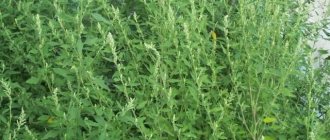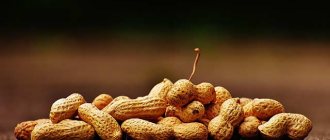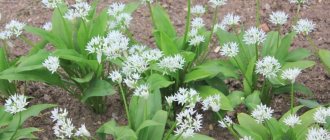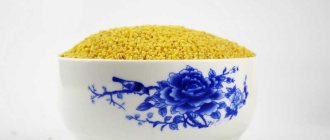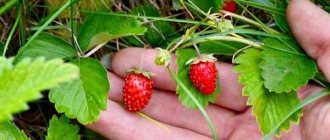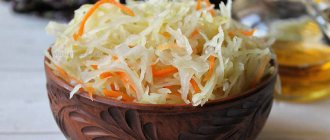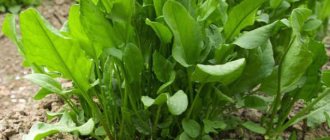Rhubarb is native to Southeast Asia. It is known that 3 thousand years ago, Tibetan monks used the root of the plant to treat many ailments. It came to Europe during the Middle Ages, where the taste and healing properties of its petioles were highly appreciated. Now rhubarb is used as a medicine and vegetable crop in all countries of the world, but it is most actively cultivated in the UK and the USA. Let's find out why this plant is so valued and how to use it correctly for health and longevity.
general characteristics
Many can be stumped by the question: “What is rhubarb: a vegetable or a fruit?” From a botanical point of view, it is a vegetable, but its taste and use in the kitchen is more similar to a fruit. In English-speaking countries, rhubarb is called “pie plant,” which translates as “pie plant.” And all because these stems, along with many berries and fruits, are often used by Americans as a filling for sweet pastries.
Content:
- general characteristics
- Chemical composition and nutritional characteristics
- Beneficial features
- Use in folk medicine
- Use in cosmetology
- Potential harms of rhubarb
- How to choose and store correctly
- Use in cooking
- Other Benefits of Rhubarb
The stems of this plant are very reminiscent of celery stalks. But in rhubarb they are not only bright green, but often with a crimson tint. And their taste is very reminiscent of the taste of green apples, and all because rhubarb contains malic acid (the same substance found in apples and grapes).
It may seem strange, but rhubarb is botanically related to buckwheat and belongs to the buckwheat family. Rhubarb is a perennial plant that can live for more than 20 years in optimal conditions. But the concept of “optimal conditions” in the case of rhubarb does not mean that the plant requires particularly careful care or is capricious to climatic conditions.
Biologists believe that this culture is native to the lands of Western China, Tibet, Mongolia and Siberia. Since ancient times, the dried root of the plant has been used in these regions. It has been used to treat a wide range of diseases. But the powerful healing properties also affected the cost of the medicine, and not only in the East. For example, in France in the 16th century, rhubarb was 10 times more expensive than cinnamon, and in England in the 17th century it was 2 times more expensive than opium. But despite such popularity of the plant, Europeans began to eat it en masse only in the 18th century. Interestingly, at this time, rhubarb was used in the kitchen only for making drinks and as an ingredient in meat stews. By the way, due to the fact that rhubarb easily takes root in almost any area and grows quickly, for a long time it was considered a weed.
Only the stems of the plant are used for food. The leaves and roots contain a lot of oxalic acid, which in large quantities acquires toxic properties. In particular, if this substance enters the body, it can cause kidney failure. And 19.2 g of oxalic acid for a person weighing 50 kg is a completely lethal dose.
Benefits of rhubarb for the body
Rhubarb as a medicine is used not only in official, but also in folk medicine. Thus, a large amount of vitamin in rhubarb allows the vegetable to be used as a prevention of vitamin deficiency, anemia and even scurvy.
Benefits for women
Several medicinal properties of rhubarb will be especially useful for the female body. Firstly, a significant concentration of vitamin E improves the general condition of the body. In particular, skin and nails, and also improves hair condition and reduces hair loss. Secondly, an infusion of its roots can be used as an antispasmodic, which is especially valuable during the menstrual period. Thirdly, eating this vegetable has a positive effect on maintaining vision (this, of course, applies not only to women).
Benefits for men
For men, consuming this plant can be beneficial in several cases:
- Prevention of cardiovascular diseases - this is facilitated by improving blood circulation, lowering cholesterol levels, and dilating blood vessels.
- In the case of regular use of tobacco products and (or) alcohol, rhubarb reduces the negative effects on the body, removes toxins, and eases hangover syndrome.
- You can use the plant to improve memory.
For weight loss
Since the calorie content of the vegetable is low, it can be safely used in the process of losing weight. You can eat it raw or as part of other dishes. At the same time, dishes containing rhubarb can be baked or stewed, but cannot be fried.
Important! When using rhubarb for weight loss, the main thing is not to overdo it with the amount.
If while following a diet the digestion process worsens, you need to stop eating the vegetable and return to your usual diet. There is no diet focused specifically on this plant (like chocolate or cabbage), since consuming a large amount of it will lead to food poisoning.
Recommended reading: Benefits of black olives
Rhubarb is used in the same way as any other vegetable when losing weight.
Chemical composition and nutritional characteristics
Rhubarb is one of the least calorie vegetables. 100 g of petioles contain only 21 kcal. However, this vegetable is rich in many vital substances such as fiber, polyphenolic antioxidants, minerals and vitamins. Another benefit of rhubarb is that it is free of cholesterol and saturated fat.
The stems are rich in B-complex vitamins, including folic acid, riboflavin, niacin, pyridoxine, thiamine and pantothenic acid. The vegetable can also be considered a good source of vitamin A. But it should be noted that the red petioles contain much more of this useful substance than the green ones. In particular, the bright petioles can be considered as a potential source of three forms of provitamin A: beta-carotene, zeaxanthin and lutein. Possessing the properties of powerful antioxidants, these substances are useful for maintaining healthy skin and mucous membranes. Well, perhaps the most famous benefit of this vitamin is its benefits for vision. Scientific research confirms that vitamin A is an essential component for healthy eye function. In addition, some laboratory experiments indicate the benefits of vitamin A in preventing lung cancer and malignant tumors in the oral cavity.
Like other green vegetables such as kale or spinach, rhubarb stems provide plenty of vitamin K. 100g of fresh stems contain about 30 mcg of this nutrient, which is almost a quarter of the daily value of the vitamin. The benefits of vitamin K include maintaining healthy bones and proper blood clotting, preventing damage to neurons in the brain, and this is an important prevention of Alzheimer's disease.
In addition, the petioles are rich in useful minerals such as iron, copper, calcium, potassium, phosphorus and others.
But it must be said that the body does not have time to absorb a significant part of them, since in combination with oxalic acid the bioavailability of minerals decreases. Nutritional value per 100 g
| Calorie content | 21 kcal |
| Squirrels | 0.9 g |
| Fats | 0.2 g |
| Carbohydrates | 4.54 g |
| Vitamin A | 102 IU |
| Vitamin C | 8 mg |
| Vitamin E | 0.27 mg |
| Vitamin K | 29.3 mcg |
| Vitamin B1 | 0.02 mg |
| Vitamin B2 | 0.03 mg |
| Vitamin B3 | 0.3 mg |
| Vitamin B5 | 0.085 mg |
| Vitamin B6 | 0.024 mg |
| Vitamin B9 | 7 mcg |
| Potassium | 288 mg |
| Sodium | 4 mg |
| Calcium | 86 mg |
| Copper | 0.021 mg |
| Iron | 0.22 mg |
| Magnesium | 12 mg |
| Manganese | 0.2 mg |
| Phosphorus | 14 mg |
| Zinc | 0.1 mg |
| Selenium | 1.1 mcg |
Beneficial features
Rhubarb is one of the oldest medicinal plants used in Chinese medicine. In China and Korea, rhubarb extract is traditionally used to prevent and treat many ailments, including ulcers, cancer, fever, headaches, toothaches, and some liver diseases. In the European tradition, rhubarb is famous as a cure for constipation, diarrhea, and flatulence. And in recent years, this plant has become the object of scientific research, the results of which have revealed many of the benefits of the vegetable.
Protects against cancer
British scientists first started talking about the fact that rhubarb has anti-cancer properties in 2012. The pink colored stems have antioxidant properties. And all thanks to the content of flavonoids, which help protect cells and DNA from the harmful effects of free radicals and mutation. In addition, the vegetable contains small amounts of another powerful antioxidant - manganese.
In addition, researchers found organic compounds in the plant, anthraquinones, which also have anti-cancer properties. In particular, preliminary studies indicate that these substances cause self-destruction of cancer cells in the liver. And scientists from Singapore believe that rhubarb juice is useful for stomach cancer, especially after surgery. But still, scientists are in no hurry to draw final conclusions, as they plan to continue research in this direction.
Improves heart and vascular health
Rhubarb does not contain cholesterol and caffeine, which makes it safe for the heart and blood vessels. In addition, 100 g of vegetable contains almost 2 g of fiber, and it is also beneficial for the cardiovascular system, at least because it helps cleanse the body of excess cholesterol. American researchers conducted an experiment: for 4 weeks, subjects received 27 g of fiber from rhubarb. As a result, their bad cholesterol levels decreased by 8%. And within a month after removing rhubarb from the diet, cholesterol levels returned to their original levels.
Strengthens immunity
A serving of rhubarb provides almost 13% of the daily value of vitamin C, a powerful antioxidant, anti-inflammatory and antimicrobial agent. Having a sufficient amount of vitamin C in the body is the key to good immunity, beautiful skin, strong blood vessels and the ability to resist inflammation.
Natural laxative
Rhubarb roots and petioles contain unique substances that have a laxative effect. Due to this, the vegetable is considered useful in treating constipation. Don't forget that the fiber contained in rhubarb is also useful for improving intestinal motility.
Reduces blood sugar
Many studies indicate that rhubarb helps lower blood sugar. In addition, the plant itself contains a low concentration of glucose, which prevents a rise in sugar in the bloodstream.
Other benefits of rhubarb:
- useful for detoxifying the body;
- strengthens blood vessels;
- promotes weight loss;
- improves brain function;
- relieves symptoms of menopause;
- stabilizes blood clotting;
- reduces blood pressure;
- a source of nutrients for pregnant and nursing mothers;
- strengthens bones and teeth;
- improves blood circulation.
Rhubarb: benefits and harm
We can talk about how useful rhubarb is for quite a long time. First of all, it is worth finding out its basic composition in order to understand how useful this plant is. But not every rhubarb has the set of beneficial properties that is attributed to it. In our country, you can find a plant that may be tasty, but less effective. But in Tibet and China, “yellow roots” grow, which have been used for a couple of thousand years as an excellent antipyretic. When considering rhubarb, the benefits and harms of which have long been studied, one should prepare for small discoveries of its basic properties.
The following beneficial properties of rhubarb should be highlighted:
- Treatment of burns.
- Elimination of psoriasis.
- Choleretic properties.
- Anti-inflammatory agent.
- Appetite stimulant.
- Improves liver function.
- Anti-inflammatory medicine for the treatment of stomach.
- Eliminates variance.
- A general tonic for anemia, sclerosis and pulmonary diseases.
- Has a mild laxative effect.
- Used for weight loss and constipation treatment.
- Has anti-scurvy properties.
It should be noted that rhubarb has different uses in treatment. But for many years it has been an excellent assistant in the fight against many diseases.
Despite the fact that rhubarb root is very useful, there are certain contraindications that should be followed before using the plant:
- Rheumatism.
- Intestinal obstruction and inflammatory processes occurring in it.
- Bleeding in the stomach and intestines.
- Kidney disease.
- Urolithiasis disease.
- Pregnancy and breastfeeding.
- Childhood.
Rhubarb is undeniably a valuable plant. But it must be used wisely so as not to cause undeniable harm to the body.
Medicinal properties of rhubarb
Due to its chemical composition, the medicinal properties of rhubarb can be listed for quite a long time. Considering that it contains vitamins: C, K, E, 33, B1, B2; acids: malic, chrysophonic, oxalic, succinic, citric; salts: potassium, iron, phosphorus, magnesium, sodium; Sahara; tannins; fatty acid; alimentary fiber; pectins; glycoside chrysophan; tannins; all kinds of resins; starch. This is a real storehouse of wealth used to treat many diseases, especially in the field of digestion.
Rhubarb: contraindications for use
Despite all the benefits of this plant, from roots to tops, rhubarb has contraindications for use, although not extensive, but they should still be carefully remembered and not taken if you have at least one of them. Under no circumstances should rhubarb be used as a medicine by pregnant and lactating women, as well as children. Excessive consumption of rhubarb can lead to increased peristalsis.
In case of kidney diseases and urolithiasis, rhubarb has serious contraindications for use, since it can provoke active movement of stones.
When the intestines are inflamed and there is bleeding from it, then it is also preferable to avoid using rhubarb.
Use in folk medicine
In folk medicine, rhubarb is known as a cure for tuberculosis, liver diseases, intestinal inflammation, constipation, anemia, colitis, enteritis, bile duct dispersion, gastritis with low acidity, and flatulence. In addition, it has anti-inflammatory and antiseptic properties.
Dried roots of the plant are included in preparations to remove bile from the body and improve stomach function. In dry form, powder from the roots is used to speed up the healing of wounds and burns.
It is useful to take rhubarb infusion as a laxative. It is prepared from 2 tablespoons of dried crushed root and a glass of boiling water. Take it as a tea at night. And if the same amount of root is poured into 1.5 cups of boiling water and steamed for 30 minutes, you will get a remedy for anemia, hypertension and nosebleeds.
A cure for hepatitis can be prepared from dried rhubarb roots. Herbalists recommend 2 tbsp. l. powder from the roots, pour 0.5 liters of boiling water and leave in a water bath for 20 minutes. Then pour everything into a thermos and leave overnight. The finished strained infusion is taken before each meal, 1 tablespoon (you can add a teaspoon of honey each time).
The use of rhubarb in treatment
If you look at it, the use of rhubarb in treatment is very wide. There are many recipes to help cope with many diseases. Here is a partial list of what can be cured by regularly using rhubarb in one form or another:
- Anemia.
- Constipation.
- Tuberculosis.
- Jaundice.
- Gastritis.
- Anorexia.
- Colic.
- Haemorrhoids.
Regular use of rhubarb is effective in treating these diseases. In each specific case, there is its own recipe for the preparation and frequency of taking medicine made from rhubarb. In addition, you need to take into account that rhubarb can be used in treatment both leaves and stems with roots.
Rhubarb roots: application
Rhubarb roots are used to treat certain diseases. Their use should be under strict control, since exceeding the dose can cause a worsening of the situation.
So, to treat diseases, you need to prepare the plant as follows:
- The age of the root must be at least 4 years, since young roots have practically no beneficial properties.
- In autumn, the root is dug up, cut and dried at a temperature of 60 degrees.
- The dried root can be stored in the refrigerator for no more than 3 years.
- Before use, the root is ground using a coffee grinder.
This is how you should prepare the rhubarb roots. Their use in medicine is quite widespread. Rhubarb root prepared in this way can be used for gastritis, enteritis, intestinal atony, hemorrhoids, anemia, dispersion, poor appetite, rectal fissure, tuberculosis, constipation and jaundice.
The cooking recipe in this case is quite simple: pour 1 tablespoon of chopped root with a glass of chilled boiling water, let it brew for 8 hours. Before use, boil for 3-5 minutes. Strain and take 1/3 cup before each meal.
Such a simple recipe helps to cope with many diseases. Despite the fact that rhubarb has a very wide range of uses in treatment, it is important not to overdo it.
Rhubarb leaves: application
If you take rhubarb leaves, they should have the following uses:
- Constipation. This delicate problem can be quite easily resolved by consuming the leaves raw. But, it is important to remember that you cannot consume more than 100 grams of rhubarb at one time, as it may cause stomach problems.
- Cataract. A decoction of the leaves is very effective in the initial stages of this disease. Even with the slightest deterioration in vision, it can be brought back to normal by consuming such a decoction daily.
- Increased blood sugar levels. Eating salad leaves daily can help stabilize your sugar levels.
- Cleansing the body of toxins. Chew a few leaves daily.
Despite the fact that rhubarb leaves are not very widely used for the treatment of various diseases, they are practically irreplaceable for cooking.
Rhubarb stems
For the most part, rhubarb stems have gastronomic value. What can they cook from it? But, rhubarb stems are good to consume to improve digestion. Thanks to the large amount of fiber and acids, metabolic processes in the intestines are activated.
Rhubarb stems have minor properties that affect the cleansing of the liver from stagnant processes. Their choleretic properties should not be ignored either.
Due to the large amount of vitamins contained in rhubarb stems, it is used as an immunostimulant.
Rhubarb juice
It contains a whole storehouse of vitamins. Therefore, rhubarb juice is good to use during colds. With hepatitis, you simply cannot do without it. You can also use rhubarb juice to combat constipation. Rhubarb juice does an excellent job of cleansing the body of toxins and strengthening the immune system. In addition, with the help of rhubarb juice you can perfectly combat negative environmental factors. Rhubarb juice is also beneficial for people suffering from tuberculosis. With its help, the respiratory system is perfectly cleansed.
Rhubarb extract
If we talk about rhubarb extract, then to a greater extent it is used to cleanse the intestines with just a couple of drops and you can forget about long-term and painful constipation. But, to obtain a stable effect, it is necessary to complete the full course of use in order to achieve a positive result and consolidate it for a long time.
Use in cosmetology
Rhubarb is a storehouse of vitamin A. This natural antioxidant helps neutralize free radicals, delay the appearance of wrinkles, and maintain healthy skin. In addition, the juice of this plant is known for its antibacterial and antifungal properties. The crushed pulp of the vegetable effectively eliminates many skin infections.
Hair also benefits from this plant. For example, thanks to oxalic acid, a decoction or infusion of rhubarb root restores shine to colored hair. But in order to avoid harmful effects on the skin, the product should not be kept on the head for a long time. It is better to use a decoction of the root for rinsing. This remedy is prepared as follows: take 2 glasses of water for 3 tablespoons of dry roots, boil for 15 minutes and leave overnight.
Potential harms of rhubarb
Only the petioles of the plant are edible; its greens and roots are dangerous to health, and in certain quantities can even cause death.
The biggest danger with rhubarb is oxalic acid (oxalates). The oxalates found in the raw plant can cause a variety of side effects, from burning in the eyes, throat and mouth to swelling, difficulty breathing, seizures and even kidney failure. Additionally, some researchers suggest that consuming large amounts of oxalates causes calcium deficiency by minimizing the body's ability to absorb the mineral. But at the same time, it should be said that boiled rhubarb stalks are not dangerous to humans.
How to choose and store correctly
The rhubarb season begins in April-May and lasts throughout the summer. But growing the plant in greenhouses makes it available all year round. When choosing rhubarb, it is important to pay attention to the appearance of the vegetable. The most delicious and healthy are fresh stems, which are characterized by shiny skin and a hard, juicy stem. But petioles with spots or damage should be avoided.
Fresh stems can be stored in the refrigerator for up to a week. To prevent moisture loss, keep petioles previously cleared of leaves in plastic bags or plastic containers. To store rhubarb for a longer period, it can be frozen or canned.
Delicious preserves
The beneficial properties of rhubarb for the body when preserved are manifested in the form of a tonic, tonic, and digestion-improving effect. Marmalade, wine, and various sweet and sour sauces are made from rhubarb. To prepare medicines at home, dried roots, as well as dried and frozen petioles, are used.
Stem compote
Peculiarities. To prepare a delicious rhubarb compote, you can add apples, raisins, citrus fruits, cinnamon, cloves, and vanilla sugar. The amount of sugar, fruit, stalks and spices can be varied to suit your taste.
Preparation and use
- The petioles, cleared of leaves, are washed with running water.
- The petioles are cut into cubes and poured with cold water for 20 minutes to compact their structure.
- Boil water in a saucepan, add sugar at the rate of half a glass of sugar per liter of water. Add additional ingredients and rhubarb.
- After boiling gently for half an hour, the compote is poured into prepared jars and sealed with lids.
Juice and candied fruits
Peculiarities. These blanks are made simultaneously. The result is two healthy and tasty products.
Preparation and use
- Leaves are cut from rhizomes. Separate the petioles and leaf blade.
- The petioles are washed with cold water, dried, and cut into pieces.
- The chopped petioles are sprinkled with sugar. Place under a press for a day.
- The released juice is drained, boiled and rolled into sterilized jars.
- The petioles are laid out on a baking sheet lined with parchment and placed in the oven to dry at 60°C. Ready candied fruits should be stored in linen bags.
Jam
Peculiarities. The drug is contraindicated in diabetes; it is given to children with caution due to the high sugar content. Perfect for adding to tea, baking, to support body tone during the cold season.
Preparation and use
- The petioles are separated from the underground part and leaf blades and washed with cold water.
- The petioles are cut into cubes and covered with powdered sugar overnight, maintaining a 1:1 ratio.
- In the morning, the resulting mixture is brought to a boil. Add a rosemary branch and cook for ten minutes.
- Pour the jam into prepared jars and seal them.
The jam will have an interesting taste if you add bananas, citrus fruits or spices.
Use in cooking
Best materials of the month
- Coronaviruses: SARS-CoV-2 (COVID-19)
- Antibiotics for the prevention and treatment of COVID-19: how effective are they?
- The most common "office" diseases
- Does vodka kill coronavirus?
- How to stay alive on our roads?
Most often, rhubarb is used to make flavored jams, baking fillings and pancakes. Rhubarb, combined with berries, fruits and nuts, can be added to ice cream, dairy desserts and smoothies. Mixing strawberry puree, rhubarb and a little lime juice, then pouring the mixture into molds and freezing makes a delicious summer sorbet. But perhaps the most common way to use rhubarb in the kitchen is as a pie filling. For many, these pies remind us of childhood.
But rhubarb can also serve as a very tasty addition to meat. For example, it goes well with fried pork, duck or game birds. A particularly winning combination in a meat sauce is rhubarb and cranberries. And cut into small slices and seasoned with vinegar, it will perfectly complement salads.
Fresh stems are washed and cleared of the outer protective film. To prepare desserts and sauces, as a rule, take rhubarb, cut into slices 1-1.5 cm wide. You should not cook the petioles in dishes made of iron, aluminum or copper, since the substances contained in the vegetable react with the metal and lead to changes the color of the rhubarb dish and the dishes themselves. Vessels made of glass or coated with a non-stick layer are best suited for these purposes.
Other Benefits of Rhubarb
Oxalic acid in large quantities can be dangerous to humans, but in some cases it is this substance that makes rhubarb especially beneficial. For example, when you need to get rid of aphids. This pest is known to many gardeners. Moreover, it is not so easy to get rid of it. But there is an excellent remedy against unwanted guests - a decoction of rhubarb leaves. Take a liter of water for 3-5 sheets and cook everything together for about 30 minutes. Then add a little laundry soap to the strained liquid. Leaves with aphids are sprayed with a cooled product. But this mixture should not be sprayed on leafy vegetables, such as cabbage, since rhubarb poison remains on the leaves.
There are probably no people who don’t know what rhubarb is. These sweet and sour stems are a favorite treat for many children and adults. And I must say - a very healthy delicacy. So don't miss rhubarb season to replenish your body's nutrients.
More fresh and relevant information about health on our Telegram channel. Subscribe: https://t.me/foodandhealthru
We will be grateful if you use the buttons:
Rhubarb decoction
This use of the plant is most popular. Due to the fact that contraindications for rhubarb decoction from leaves and stems are minimal and it has a stable effect, we should talk about its benefits. First of all, rhubarb decoction stimulates the immune system and helps fight inflammatory processes.
Intestinal function is normalized. In addition, rhubarb decoction is recommended to stimulate appetite. It has a weak choleretic property.
Rhubarb decoction prepared from the root of the plant is effective for diseases of the liver, gastrointestinal tract, tuberculosis, constipation, hemorrhoids, hepatitis and some other diseases.
How to prepare a decoction of rhubarb roots
To combat most diseases, a decoction of rhizomes is needed. Therefore, knowing how to prepare a decoction of rhubarb roots, you can immediately fight several ailments at the same time. First of all, you should get some rhubarb horse powder. You can buy it at the pharmacy or prepare it yourself.
For 4 tablespoons of rhubarb powder you need to take 1 liter of boiled water. Pour in and let sit for 10-12 hours. During this time, all the beneficial properties concentrated in the powder will pass into the water. To enhance the effect, the resulting tincture should be boiled for 5 minutes and allowed to cool. After the broth has cooled, you should strain it. Use based on need for specific diseases.
Making a decoction of rhubarb leaves
In order to learn how to stimulate your digestion correctly, it is worth mastering the preparation of a decoction of rhubarb leaves. The recipe is quite simple. It is worth crushing 200 grams of rhubarb leaves and pouring 2 liters of boiling water. Place in a water bath and boil for 3 minutes. Wrap it well and let it brew for 2-3 hours. After this, strain and consume half a glass before each meal. In addition, this remedy will help overcome a severe hangover, as it has excellent cleansing properties.

